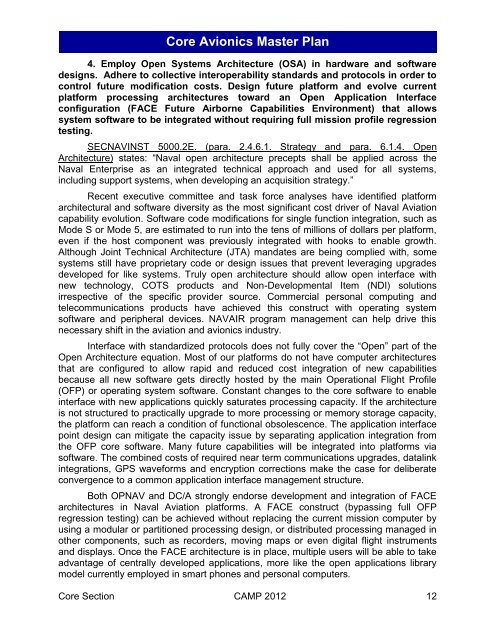PMA209 2012 Core Avionics Master Plan - NAVAIR - U.S. Navy
PMA209 2012 Core Avionics Master Plan - NAVAIR - U.S. Navy
PMA209 2012 Core Avionics Master Plan - NAVAIR - U.S. Navy
You also want an ePaper? Increase the reach of your titles
YUMPU automatically turns print PDFs into web optimized ePapers that Google loves.
<strong>Core</strong> <strong>Avionics</strong> <strong>Master</strong> <strong>Plan</strong>4. Employ Open Systems Architecture (OSA) in hardware and softwaredesigns. Adhere to collective interoperability standards and protocols in order tocontrol future modification costs. Design future platform and evolve currentplatform processing architectures toward an Open Application Interfaceconfiguration (FACE Future Airborne Capabilities Environment) that allowssystem software to be integrated without requiring full mission profile regressiontesting.SECNAVINST 5000.2E. (para. 2.4.6.1. Strategy and para. 6.1.4. OpenArchitecture) states: “Naval open architecture precepts shall be applied across theNaval Enterprise as an integrated technical approach and used for all systems,including support systems, when developing an acquisition strategy.”Recent executive committee and task force analyses have identified platformarchitectural and software diversity as the most significant cost driver of Naval Aviationcapability evolution. Software code modifications for single function integration, such asMode S or Mode 5, are estimated to run into the tens of millions of dollars per platform,even if the host component was previously integrated with hooks to enable growth.Although Joint Technical Architecture (JTA) mandates are being complied with, somesystems still have proprietary code or design issues that prevent leveraging upgradesdeveloped for like systems. Truly open architecture should allow open interface withnew technology, COTS products and Non-Developmental Item (NDI) solutionsirrespective of the specific provider source. Commercial personal computing andtelecommunications products have achieved this construct with operating systemsoftware and peripheral devices. <strong>NAVAIR</strong> program management can help drive thisnecessary shift in the aviation and avionics industry.Interface with standardized protocols does not fully cover the “Open” part of theOpen Architecture equation. Most of our platforms do not have computer architecturesthat are configured to allow rapid and reduced cost integration of new capabilitiesbecause all new software gets directly hosted by the main Operational Flight Profile(OFP) or operating system software. Constant changes to the core software to enableinterface with new applications quickly saturates processing capacity. If the architectureis not structured to practically upgrade to more processing or memory storage capacity,the platform can reach a condition of functional obsolescence. The application interfacepoint design can mitigate the capacity issue by separating application integration fromthe OFP core software. Many future capabilities will be integrated into platforms viasoftware. The combined costs of required near term communications upgrades, datalinkintegrations, GPS waveforms and encryption corrections make the case for deliberateconvergence to a common application interface management structure.Both OPNAV and DC/A strongly endorse development and integration of FACEarchitectures in Naval Aviation platforms. A FACE construct (bypassing full OFPregression testing) can be achieved without replacing the current mission computer byusing a modular or partitioned processing design, or distributed processing managed inother components, such as recorders, moving maps or even digital flight instrumentsand displays. Once the FACE architecture is in place, multiple users will be able to takeadvantage of centrally developed applications, more like the open applications librarymodel currently employed in smart phones and personal computers.<strong>Core</strong> Section CAMP <strong>2012</strong> 12

















